The second most potent greenhouse gas that contributes to Climate Change is Methane. This one has been a bit of a puzzle because there has been a dramatic increase in it during the past decade and nobody was able to explain why.
That however has changed.
The Methane Mystery
A Washington Post article by Chris Mooney back in 2016 entitled “Atmospheric levels of methane, a powerful greenhouse gas, are spiking, scientists report” not only reported on this observation but presented the actual observations …

“Methane in the atmosphere was almost flat from about 2000 through 2006. Beginning 2007, it started upward, but in the last two years, it spiked,” said Rob Jackson, an earth scientist at Stanford University who co-wrote the study.
… it’s important to note that there remains considerable scientific uncertainty when it comes to accounting for all the complex, global sources of methane, as well as the processes that withdraw it from the atmosphere once it has been emitted. The paper fully acknowledges that these have not all been adequately understood.
There was of course speculation, and a strong leaning towards specific causes, but no hard confirmation.
Well … that has now changed.
The new study
The title of the new paper that explains what has been going on sums it up nicely …
Basically it is these guys, or to be rather specific and crude, the increase is all down to cow farts.
Our revised bottom-up estimates of global livestock methane emissions are comparable to recently reported top-down global estimates for recent years, and account for a significant part of the increase in annual methane emissions since 2007. Our results suggest that livestock methane emissions, while not the dominant overall source of global methane emissions, may be a major contributor to the observed annual emissions increases over the 2000s to 2010s. Differences at regional and local scales may help distinguish livestock methane emissions from those of other sectors in future top-down studies. The revised estimates allow improved reconciliation of top-down and bottom-up estimates of methane emissions, will facilitate the development and evaluation of Earth system models, and provide consistent regional and global Tier 1 estimates for environmental assessments.
Well yes, “cow farts” a tad simplistic, because what we are actually talking about here as the methane source is both “enteric fermentation” and also “manure management”.
Back in 2006 the IPCC (Intergovernmental Panel on Climate Change) had produced some guidelines for estimating methane that was in need of revision. A change was needed because livestock are now being fed more and bred to be bigger. Additionally, the manner in which their manure was being handled had also changed.
Once you adjust things to handle the above, they found that this happened to the numbers they had …
Using the new emissions factors, we estimate global livestock emissions of 119.1 ± 18.2 Tg methane in 2011; this quantity is 11% greater than that obtained using the IPCC 2006 emissions factors, encompassing an 8.4% increase in enteric fermentation methane, a 36.7% increase in manure management methane
This is not the final word on this
The conclusion of the study is that the uptick in agricultural industrialization has been a major contributor to the methane uptick, but doubt still exists that this explains it all. Fingers are still being pointed towards the U.S. fracking boom as a contributor as well.
Science is often like this. We have gained some further clarity, but questions still persist because often there are many layers of complexity lurking under the surface.
OK, yes, I can’t resist the obvious joke here…
If you are tempted to suggest that this is bullshit, then in this case you would indeed be scientifically correct.
Further Reading
- Scientists may have found a solution to the atmosphere’s methane mystery – Washington Post, 29th Sep, Chris Mooney
- The Open Access paper on all this